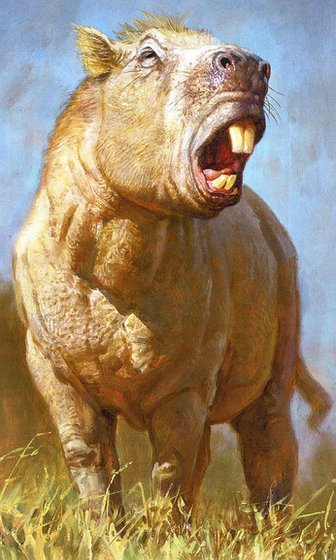Largest Prehistoric Rodent had Foot-Long Teeth Like Tusks
| Marco Foronda | | Feb 06, 2015 05:07 AM EST |
(Photo : James Gurney, University of York) The largest rodent to ever walk the Earth stood 5 feet tall and weighed more than a ton.
The largest ever rodent used its huge incisors like elephant tusks, digging for food and defending itself from predators, scientists say.
The giant relative of the puny guinea pig, which went extinct around two million years ago, weighed more than 2,000 pounds and was similar in size than a buffalo. Josephoartigasia monesi was native to South America and had a pair of powerful, foot-long incisors.
Like Us on Facebook
The current largest living rodent, the capybara, weighs a paltry 145 pounds.
Dr. Philip Cox of the Centre for Anatomical and Human Sciences at the University of York scanned a fossil skull of J. monesi. The computer modeling suggests its bite was as strong or even stronger than that of a modern tiger. Its front teeth almost a foot long could withstand forces as much as three times as large.
The specimen is missing its lower jaw, but is otherwise distinctive for its fearsome giant front teeth. Using a process called finite element analysis, researchers were able to measure how the skull would react to pressure in real time.
Cox found that Josephoartigasia had a bite force of 1,400 newtons - comparable to that of a tiger. Cox suggests the mammoth rodent's teeth could withstand three times more pressure than its own bite force.
"These results, combined with previous work, lead us to speculate that J. monesi was behaving in an elephant-like manner, using its incisors like tusks, and processing tough vegetation with large bite forces at the cheek teeth," they said.
J. monesi, the largest rodent ever discovered, lived during the warm Pliocene period when large mammals such as the first mammoths were fairly abundant.
They're sometimes called the giant pacarana after its closest living relative, the pacarana.
Details of the largest rodent discovery were published in the Journal of Anatomy.
Tagsrodent, ancient rodent, largest rodent, Josephoartigasia monesi, animal fossil, predators, Pliocene period
©2015 Chinatopix All rights reserved. Do not reproduce without permission
EDITOR'S PICKS
-

Did the Trump administration just announce plans for a trade war with ‘hostile’ China and Russia?
-

US Senate passes Taiwan travel bill slammed by China
-

As Yan Sihong’s family grieves, here are other Chinese students who went missing abroad. Some have never been found
-

Beijing blasts Western critics who ‘smear China’ with the term sharp power
-

China Envoy Seeks to Defuse Tensions With U.S. as a Trade War Brews
-

Singapore's Deputy PM Provides Bitcoin Vote of Confidence Amid China's Blanket Bans
-

China warns investors over risks in overseas virtual currency trading
-

Chinese government most trustworthy: survey
-

Kashima Antlers On Course For Back-To-Back Titles
MOST POPULAR
LATEST NEWS
Zhou Yongkang: China's Former Security Chief Sentenced to Life in Prison

China's former Chief of the Ministry of Public Security, Zhou Yongkang, has been given a life sentence after he was found guilty of abusing his office, bribery and deliberately ... Full Article
TRENDING STORY

China Pork Prices Expected to Stabilize As The Supplies Recover

Elephone P9000 Smartphone is now on Sale on Amazon India

There's a Big Chance Cliffhangers Won't Still Be Resolved When Grey's Anatomy Season 13 Returns

Supreme Court Ruled on Samsung vs Apple Dispute for Patent Infringement

Microsoft Surface Pro 5 Rumors and Release Date: What is the Latest?










